Esmé Raji Codell's Blog, page 9
January 9, 2011
ON THE EVE OF THE CALDECOTT/NEWBERY AWARDS
 Throughout the world of children's literature comes the call: "Who? WHO? Whoooooo?" No, it it is not a forest full of owls, it is the community of librarians, teachers and kidlit enthusiasts all wondering who will take the coveted ALA/ALSC Library Media Awards, the Caldecott for best American children's book illustration, the Newbery for best children's book writing, and a bevy of other significant commendations (Sibert for non-fiction, Coretta Scott King and Pura Belpre Awards for African American and Latino/Latina children's lit, Theodore Geisel for early readers). These are better known the "Oscars" of Children's Literature (and even better known as "Day of Disappointment" for 99.9% of author/illustrators, but oh, well). You can view the webcast live tomorrow at 7:45 San Diego time (that's 9:45 to you, Midwesterners, and 10:45, East Coast). Who is going to take the silver and gold? Please forgive some informal musing to follow...
Throughout the world of children's literature comes the call: "Who? WHO? Whoooooo?" No, it it is not a forest full of owls, it is the community of librarians, teachers and kidlit enthusiasts all wondering who will take the coveted ALA/ALSC Library Media Awards, the Caldecott for best American children's book illustration, the Newbery for best children's book writing, and a bevy of other significant commendations (Sibert for non-fiction, Coretta Scott King and Pura Belpre Awards for African American and Latino/Latina children's lit, Theodore Geisel for early readers). These are better known the "Oscars" of Children's Literature (and even better known as "Day of Disappointment" for 99.9% of author/illustrators, but oh, well). You can view the webcast live tomorrow at 7:45 San Diego time (that's 9:45 to you, Midwesterners, and 10:45, East Coast). Who is going to take the silver and gold? Please forgive some informal musing to follow...The horse race for the Newbery points toward THE DREAMER
 by Pam Munoz Ryan, a piece of magical realism that depicts the childhood of poet Pablo Neruda, backed by the ethereal art of Caldecott winner Peter Sis...
by Pam Munoz Ryan, a piece of magical realism that depicts the childhood of poet Pablo Neruda, backed by the ethereal art of Caldecott winner Peter Sis...
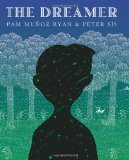 and ONE CRAZY SUMMER
and ONE CRAZY SUMMER by Rita Williams-Garcia, the sensitively told story of a girl in the late 1960's whose mother is involved in the Black Panther movement.
by Rita Williams-Garcia, the sensitively told story of a girl in the late 1960's whose mother is involved in the Black Panther movement.
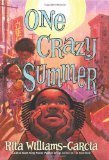


Perfectly deserving recipients and original reads, both, but I am still laying some coins down on a few dark horses. There are other worthy contenders with middle grade readerships who could take it, each using history to tune in to the readership of today, excellent books that will speak to children in this economy. Namely, THE YEAR MONEY GREW ON TREES
 by Aaron Hawkins (Houghton Mifflin), a lively story set in the Great Depression about a family who tries to survive by starting their own apple orchard. Then there is TO COME AND GO LIKE MAGIC
by Aaron Hawkins (Houghton Mifflin), a lively story set in the Great Depression about a family who tries to survive by starting their own apple orchard. Then there is TO COME AND GO LIKE MAGIC
 by Katie Pickard Fawcett (Knopf), set in 1970's Appalachia in which Chili Sue Mahoney longs to see the world outside of Kentucky, and finds herself living vicariously through her teacher. Then there is the little gem PALACE BEAUTIFUL
by Katie Pickard Fawcett (Knopf), set in 1970's Appalachia in which Chili Sue Mahoney longs to see the world outside of Kentucky, and finds herself living vicariously through her teacher. Then there is the little gem PALACE BEAUTIFUL
 by Sarah DeFord Williams (Putnam) with an unfortunately non-Newbery looking cover and already in paperback (ye of little faith), but inside is the poignant-with-a-capital-P story of a girl who finds a journal of a girl suffering through the flu epidemic of 1918, and finds the worlds of then and now converging; short and sweet, this is the most unassuming heavyweight contender read since Patricia MacLachlan's SARAH, PLAIN AND TALL. You heard it here first.
by Sarah DeFord Williams (Putnam) with an unfortunately non-Newbery looking cover and already in paperback (ye of little faith), but inside is the poignant-with-a-capital-P story of a girl who finds a journal of a girl suffering through the flu epidemic of 1918, and finds the worlds of then and now converging; short and sweet, this is the most unassuming heavyweight contender read since Patricia MacLachlan's SARAH, PLAIN AND TALL. You heard it here first.
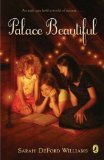
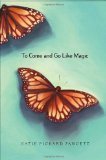
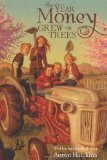

On to the Caldecotts. All eyes and runny noses are on A SICK DAY FOR AMOS McGEE
 by Philip and Erin Stead (Roaring Brook, reviewed here), a perfectly respectable choice, if a bit old-skool (but don't we love old skool?)...
by Philip and Erin Stead (Roaring Brook, reviewed here), a perfectly respectable choice, if a bit old-skool (but don't we love old skool?)...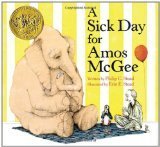 and illustrator John Muth, coupled with our golden boy (or rather, golden man) Mo Willems in the role of author, for CITY DOG, COUNTRY FROG
and illustrator John Muth, coupled with our golden boy (or rather, golden man) Mo Willems in the role of author, for CITY DOG, COUNTRY FROG , which is pretty darn timeless and will probably take it...
, which is pretty darn timeless and will probably take it...
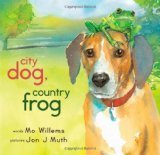
 but that can't stop me from rooting for some love to go to G. Brian Karas's artwork in CLEVER JACK TAKES THE CAKE
but that can't stop me from rooting for some love to go to G. Brian Karas's artwork in CLEVER JACK TAKES THE CAKE , done with Candace Fleming, two talented children's book workhorses who also deserve recognition.
, done with Candace Fleming, two talented children's book workhorses who also deserve recognition.
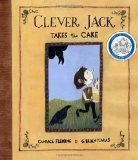

Luckily for American illustrators, Jeannie Baker (MIRROR) is from Australia and Suzy Lee (SHADOW) is from Singapore, or my oh my, with respect I have to say they would have given this year's crop a run for their money.
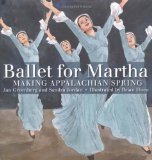
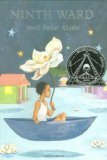
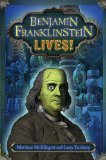 These awards are meant to represent the excellence of the larger whole, and so books like these will probably get awards: BALLET FOR MARTHA: MAKING APPALACHIAN SPRING
These awards are meant to represent the excellence of the larger whole, and so books like these will probably get awards: BALLET FOR MARTHA: MAKING APPALACHIAN SPRING , for instance; Susan Campbell Bartoletti's brave and well-researched THEY CALL THEMSELVES THE K.K.K.
, for instance; Susan Campbell Bartoletti's brave and well-researched THEY CALL THEMSELVES THE K.K.K. ; Sharon Draper's gotten lots of buzz for her novel OUT OF MY MIND; if David Weisner has any more room on his shelf for more prizes, he might take it for ART & MAX
; Sharon Draper's gotten lots of buzz for her novel OUT OF MY MIND; if David Weisner has any more room on his shelf for more prizes, he might take it for ART & MAX ; and BINK AND GOLLY
; and BINK AND GOLLY is a shoo-in for a Geisel (who can resist Kate DiCamillo matching wits with Alison McGhee, coupled with David Fucile's work that is as fun as any television cartoon?). Yes, I am a librarian, and I can recognize the distinguished qualities of some books. But as a teacher librarian for elementary school kids, I have my own favorites based on what works well in classrooms...I look for distinguished books with a pragmatic edge.
is a shoo-in for a Geisel (who can resist Kate DiCamillo matching wits with Alison McGhee, coupled with David Fucile's work that is as fun as any television cartoon?). Yes, I am a librarian, and I can recognize the distinguished qualities of some books. But as a teacher librarian for elementary school kids, I have my own favorites based on what works well in classrooms...I look for distinguished books with a pragmatic edge.  Marilyn Singer's MIRROR, MIRROR
Marilyn Singer's MIRROR, MIRROR
 for sheer inventiveness. Laura Amy Schlitz's THE NIGHT FAIRY, short and action-packed, a perfect read-aloud. THE DARK EMPEROR, so handsome, DOTTY, so wise. I guess works like THE STRANGE CASE OF ORIGAMI YODA and BENJAMIN FRANKLINSTEIN LIVES!
for sheer inventiveness. Laura Amy Schlitz's THE NIGHT FAIRY, short and action-packed, a perfect read-aloud. THE DARK EMPEROR, so handsome, DOTTY, so wise. I guess works like THE STRANGE CASE OF ORIGAMI YODA and BENJAMIN FRANKLINSTEIN LIVES! are too base and funny to win, but by golly, how funny are they, and will anyone recognize with gold how truly hard it is to write something that funny, and how very very very much children want to read something that is that funny? And these awards do mean these books will be bought by
are too base and funny to win, but by golly, how funny are they, and will anyone recognize with gold how truly hard it is to write something that funny, and how very very very much children want to read something that is that funny? And these awards do mean these books will be bought by  the thousands and put into probably more classrooms, even, than libraries, and children will be assigned to read them...so I guess my wish is that whoever wins, let it be books that kids really like.
the thousands and put into probably more classrooms, even, than libraries, and children will be assigned to read them...so I guess my wish is that whoever wins, let it be books that kids really like.  That's why I so appreciate lists like The Allen County Public Library Mock Newbery and Mock Caldecott (impeccable taste always, by the way, my own nominations notwithstanding; this year, they chose NINTH WARD
That's why I so appreciate lists like The Allen County Public Library Mock Newbery and Mock Caldecott (impeccable taste always, by the way, my own nominations notwithstanding; this year, they chose NINTH WARD
 by Jewell Parker Rhodes for the Newbery, and mentioned the great wordless CHALK
by Jewell Parker Rhodes for the Newbery, and mentioned the great wordless CHALK by Bill Thomson as a worthy Caldecott contender), and the mighty Cybils, chosen by children's book bloggers across the kidlitosphere, always an eclectic list that offers so many opportunities to connect so many readers.
by Bill Thomson as a worthy Caldecott contender), and the mighty Cybils, chosen by children's book bloggers across the kidlitosphere, always an eclectic list that offers so many opportunities to connect so many readers.  Our own PlanetEsme Picks will be posted this month, the best of 2010. I love lists more than prizes. Motto: the more the merrier...in friends, in dishes on a table, in cookies in a jar, and in books.
Our own PlanetEsme Picks will be posted this month, the best of 2010. I love lists more than prizes. Motto: the more the merrier...in friends, in dishes on a table, in cookies in a jar, and in books. 
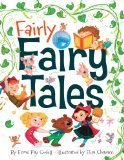

 What books did you really like this year? Who do you predict will win, and who has already won your heart? Please share in the comments section this week. One lucky winner chosen at random will get a signed copy of my new book, FAIRLY FAIRY TALES
What books did you really like this year? Who do you predict will win, and who has already won your heart? Please share in the comments section this week. One lucky winner chosen at random will get a signed copy of my new book, FAIRLY FAIRY TALES . That way, tomorrow, any way it goes, I can be assured someone I really like will win something.
. That way, tomorrow, any way it goes, I can be assured someone I really like will win something. Links are provided for informational use. Don't forget to support your local bookseller.
More Esmé stuff at www.planetesme.com.
Published on January 09, 2011 20:44
January 8, 2011
HAPPY NEW YEAR and HAPPY BOOK BIRTHDAY TO ME!
 Talk about getting off on the right foot, early January marks the release of my own picture book, FAIRLY FAIRY TALES
Talk about getting off on the right foot, early January marks the release of my own picture book, FAIRLY FAIRY TALES (Aladdin, 2011).
(Aladdin, 2011).The inspiration for this book started with an experience I had reading aloud Paul Galdone's CAT GOES FIDDLE-I-FEE
 to preschoolers, in the style taught to me by my former boss and mentor Andy Laties
to preschoolers, in the style taught to me by my former boss and mentor Andy Laties . I hold up the book, where there is clearly a picture of a duck, and carelessly say it is a picture of a tractor, or a pizza, or a rhinoceros, or a pair of underpants. The children immediately correct/chide me. "Nooooooooo!" What fun to correct dumb grown-ups! Later, when I was working on a book about preschool, I visited a classroom to brainstorm about what should go in it, and remembered this tack. I showed them a bunch of pictures of things that might be in a classroom, such as blocks, a sand table, chairs, and...a Tyrannosaurus Rex. "Nooooooo!" cried all the children, except for one boy, a literalist, who promptly went to the toy box and pulled out a seven-inch plastic dinosaur. "Well, maybe," I had to concede. We were off and running. Space alien? Well, maybe, if one landed from Saturn. Cupcake? Well, maybe, if it were somebody's birthday and someone's mom brought them in. "Noooooo" is mighty fun. But the idea of possibility...the "well, maybe!" of it all...that's even funnerer. And that's the spirit I tried to put in this book, which was originally titled Well, Maybe (until the marketers thought, well, maybe something else).
. I hold up the book, where there is clearly a picture of a duck, and carelessly say it is a picture of a tractor, or a pizza, or a rhinoceros, or a pair of underpants. The children immediately correct/chide me. "Nooooooooo!" What fun to correct dumb grown-ups! Later, when I was working on a book about preschool, I visited a classroom to brainstorm about what should go in it, and remembered this tack. I showed them a bunch of pictures of things that might be in a classroom, such as blocks, a sand table, chairs, and...a Tyrannosaurus Rex. "Nooooooo!" cried all the children, except for one boy, a literalist, who promptly went to the toy box and pulled out a seven-inch plastic dinosaur. "Well, maybe," I had to concede. We were off and running. Space alien? Well, maybe, if one landed from Saturn. Cupcake? Well, maybe, if it were somebody's birthday and someone's mom brought them in. "Noooooo" is mighty fun. But the idea of possibility...the "well, maybe!" of it all...that's even funnerer. And that's the spirit I tried to put in this book, which was originally titled Well, Maybe (until the marketers thought, well, maybe something else). A little boy has a pile of story books that he wants his mother to share at bedtime, but her reading seems a bit off. For instance, take The Three Little Pigs. Straw? Yes. Sticks? Yes. Bricks? Yes. Solar panels? Nooooooooo!
 Turn the page and...Well, maybe.
Turn the page and...Well, maybe.
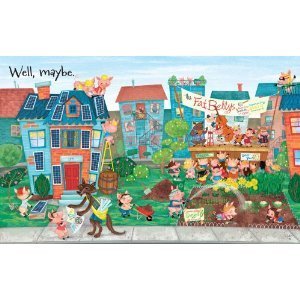
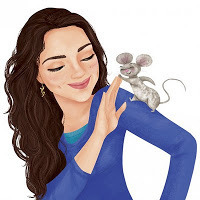 Elisa Chavarri
Elisa Chavarri

 And so it goes. Red Riding Hood has a basket and a wolf and a grandmother, but can she have a bottle of shampoo? Well, maybe. Goldilocks has porridge and bears and a bed, but can she have a television set? Well, maybe. Maybe Jack of beanstalk fame can have some spaghetti, maybe Hansel and Gretel may have a candy-filled pinata...but my favorite is Cinderella. She can have a fairy godmother and a coach and glass slippers, but can she have a disco ball? She can indeed, shaped like a glittering mosaic pumpkin, and her glass slippers are even 70's style, with goldfish in the heels. The text is minimal, but oh-la-la, I could not have asked for more in an illustrator than I found in the great Elisa Chavarri, whose work I first saw in SANTA GOES GREEN
And so it goes. Red Riding Hood has a basket and a wolf and a grandmother, but can she have a bottle of shampoo? Well, maybe. Goldilocks has porridge and bears and a bed, but can she have a television set? Well, maybe. Maybe Jack of beanstalk fame can have some spaghetti, maybe Hansel and Gretel may have a candy-filled pinata...but my favorite is Cinderella. She can have a fairy godmother and a coach and glass slippers, but can she have a disco ball? She can indeed, shaped like a glittering mosaic pumpkin, and her glass slippers are even 70's style, with goldfish in the heels. The text is minimal, but oh-la-la, I could not have asked for more in an illustrator than I found in the great Elisa Chavarri, whose work I first saw in SANTA GOES GREEN . I never met her and we never spoke directly in the process of making the book, as is customary in publishing. She just went ahead and did what every picture book author dreams an illustrator will do: she ran with it, not just visually narrating the text but adding to it, creating two voices for the one song, both hers and mine. I could not have wished for a more inventive, colorful, and beautiful execution. She is totally the star. The review periodical Kirkus said: "Her brightly colored...artwork is full of so many funny details that children will find something new with each re-reading. This will certainly keep kids on their toes as they try to guess what is coming--no maybes about that." Though my favorite review so far came from artist Tom Lichtenheld (DUCK! RABBIT!
. I never met her and we never spoke directly in the process of making the book, as is customary in publishing. She just went ahead and did what every picture book author dreams an illustrator will do: she ran with it, not just visually narrating the text but adding to it, creating two voices for the one song, both hers and mine. I could not have wished for a more inventive, colorful, and beautiful execution. She is totally the star. The review periodical Kirkus said: "Her brightly colored...artwork is full of so many funny details that children will find something new with each re-reading. This will certainly keep kids on their toes as they try to guess what is coming--no maybes about that." Though my favorite review so far came from artist Tom Lichtenheld (DUCK! RABBIT! and SHARK VS. TRAIN
and SHARK VS. TRAIN ), who quipped that it looked "like a classic Golden Book, updated." Sigh! What could be better than that?
), who quipped that it looked "like a classic Golden Book, updated." Sigh! What could be better than that? MeI am proud that, with the collaboration of our editor Emily, we have created a reading experience that will encourage audience participation, because that's how it was conceived. I am also delighted that we can reinforce folkloric knowledge and divergent thinking in the zaniest of ways through this book. But it's naughty, naughty, naughty to review one's own book, so I'll stop and now I'll leave that to you, or, more credibly, the intended audience: your children. Enjoy!
MeI am proud that, with the collaboration of our editor Emily, we have created a reading experience that will encourage audience participation, because that's how it was conceived. I am also delighted that we can reinforce folkloric knowledge and divergent thinking in the zaniest of ways through this book. But it's naughty, naughty, naughty to review one's own book, so I'll stop and now I'll leave that to you, or, more credibly, the intended audience: your children. Enjoy!Also of interest:
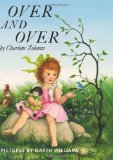 As the calendar begins anew, check out these picks that take children on a ride from January to December. My go-to has been the classic OVER AND OVER by Charlotte Zolotow and illustrated by Garth Williams
As the calendar begins anew, check out these picks that take children on a ride from January to December. My go-to has been the classic OVER AND OVER by Charlotte Zolotow and illustrated by Garth Williams
 (the artist behind CHARLOTTE'S WEB
(the artist behind CHARLOTTE'S WEB ), because I like a book that doesn't hurry along, and I can never get over the beautiful saturation of Williams' paint printed into the paper. But I lean toward the old-fashioned, and modern children have more choices for exploring the cycle of the year. Try:
), because I like a book that doesn't hurry along, and I can never get over the beautiful saturation of Williams' paint printed into the paper. But I lean toward the old-fashioned, and modern children have more choices for exploring the cycle of the year. Try: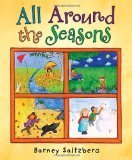
 ALL AROUND THE SEASONS by Barney Saltzberg (Candlewick, 2010), a chummy, cheerful rhyme that covers all the seasons, with generous cartoon illustrations and especially bright colors that capture everything from the pink of summer's watermelon to the cozy bronze light of a fall evening spent building a tent with chairs, blankets and a best friend. A really solid early childhood choice, children will recognize and look forward to all that's ahead in the year and in these pages.
ALL AROUND THE SEASONS by Barney Saltzberg (Candlewick, 2010), a chummy, cheerful rhyme that covers all the seasons, with generous cartoon illustrations and especially bright colors that capture everything from the pink of summer's watermelon to the cozy bronze light of a fall evening spent building a tent with chairs, blankets and a best friend. A really solid early childhood choice, children will recognize and look forward to all that's ahead in the year and in these pages.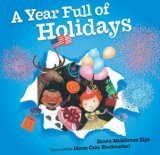 A YEAR FULL OF HOLIDAYS by Susan Middleton Elya, illustrated by Diana Cain Blumethal (Putnam, 2011)
A YEAR FULL OF HOLIDAYS by Susan Middleton Elya, illustrated by Diana Cain Blumethal (Putnam, 2011)
 is the most visually slick and modern in mood of the picks, capturing the anticipation..and near impatience...of a little girl who can hardly wait from one birthday to the next. Luckily, there is plenty to celebrate in between, including a nifty stylized double-paged spread of a multicultural Thanksgiving dinner, the bright green of a St. Patrick's Day lawn, a sky full of Fourth of July fireworks, and a family framed in an Easter basket. Each month is a present to be opened...almost as good as a birthday party.
is the most visually slick and modern in mood of the picks, capturing the anticipation..and near impatience...of a little girl who can hardly wait from one birthday to the next. Luckily, there is plenty to celebrate in between, including a nifty stylized double-paged spread of a multicultural Thanksgiving dinner, the bright green of a St. Patrick's Day lawn, a sky full of Fourth of July fireworks, and a family framed in an Easter basket. Each month is a present to be opened...almost as good as a birthday party. And have a look at SO MANY DAYS by Alison McGhee, illustrated by Taeeun Yoo (Atheneum, 2010)
 , more of a loving ode to all a child can be and do in the vein of Dr. Seuss's OH, THE PLACES YOU'LL GO! with the gentle affection of Sam McBratney's GUESS HOW MUCH I LOVE YOU
, more of a loving ode to all a child can be and do in the vein of Dr. Seuss's OH, THE PLACES YOU'LL GO! with the gentle affection of Sam McBratney's GUESS HOW MUCH I LOVE YOU . Nicely paired with books that look forward to the year, this will help children get January off on a most optimistic note. McGhee's book features incredible print illustrations against a white backdrop that will appeal to fans of Jen Corace (LITTLE PEA
. Nicely paired with books that look forward to the year, this will help children get January off on a most optimistic note. McGhee's book features incredible print illustrations against a white backdrop that will appeal to fans of Jen Corace (LITTLE PEA ). Yoo's artwork is available on etsy.com, and just check out this illustration to describe the text, "you are braver than you know."
). Yoo's artwork is available on etsy.com, and just check out this illustration to describe the text, "you are braver than you know."
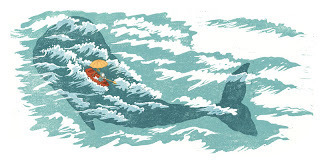 (And you are, you know.) Happy New Year!
(And you are, you know.) Happy New Year!Links are provided for informational use. Don't forget to support your local bookseller.
More Esmé stuff at www.planetesme.com.
Published on January 08, 2011 12:06
December 30, 2010
CLEVER JACK TAKES THE CAKE (PICTURE BOOK)
PICTURE BOOK

 CLEVER JACK TAKES THE CAKE by Candace Fleming, illustrated by G. Brian Karas (Schwartz & Wade, 2010)
CLEVER JACK TAKES THE CAKE by Candace Fleming, illustrated by G. Brian Karas (Schwartz & Wade, 2010)
Jack is bringing a gift to the princess for her birthday, and he has it all planned out. Even though he's broke, he's going to make the best with what he has.
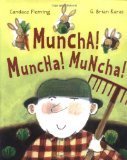
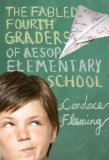 Candace Fleming is crazy versatile in her gift for writing, penning ambitious and well-researched historical nonfiction for kids (check out BEN FRANKLIN'S ALMANAC
Candace Fleming is crazy versatile in her gift for writing, penning ambitious and well-researched historical nonfiction for kids (check out BEN FRANKLIN'S ALMANAC , THE LINCOLNS
, THE LINCOLNS or my personal favorite, A BIG CHEESE IN THE WHITE HOUSE: THE TRUE TALE OF A TREMENDOUS CHEDDAR
or my personal favorite, A BIG CHEESE IN THE WHITE HOUSE: THE TRUE TALE OF A TREMENDOUS CHEDDAR ), picture books (like the clever and popular MUNCHA, MUNCHA, MUNCHA
), picture books (like the clever and popular MUNCHA, MUNCHA, MUNCHA ,
, done in collaboration with this same illustrator), a besides her special penchant for the historical, she has a flair for the folkloric (case in point: THE FABLED FOURTH GRADERS OF AESOP ELEMENTARY
done in collaboration with this same illustrator), a besides her special penchant for the historical, she has a flair for the folkloric (case in point: THE FABLED FOURTH GRADERS OF AESOP ELEMENTARY , which has a sequel, THE FABLED FIFTH GRADERS
, which has a sequel, THE FABLED FIFTH GRADERS ), proving she can juggle genres with the aplomb of the great Avi. But though all her books are consistently special, there is something especially flawless in this one, a chef d'oeuvre of sorts, even on an already heavy shelf of accomplishment. Her equally prolific illustrator, using his standard charming colored pencil and watercolor technique, has stepped up his game here, starting on the endpapers with a black cloud of foreboding forest and an almost romantic moonlit chat between the princess and Jack awaiting on the other side, with exciting variation of layout in between.
), proving she can juggle genres with the aplomb of the great Avi. But though all her books are consistently special, there is something especially flawless in this one, a chef d'oeuvre of sorts, even on an already heavy shelf of accomplishment. Her equally prolific illustrator, using his standard charming colored pencil and watercolor technique, has stepped up his game here, starting on the endpapers with a black cloud of foreboding forest and an almost romantic moonlit chat between the princess and Jack awaiting on the other side, with exciting variation of layout in between.  Besides being a perfect marriage of text and art, this deceptively simple book is a pretty flawless read-aloud, inviting both attention and participation from the listener and should be a contender for the Geisel Award. It belongs on every child's shelf, and is a must-have for starting fairy tale units and a sure-fire "read it again!" choice for the lap or the nap. Sweet and with just the right mix of storytime ingredients, just like a good cake, it rises to the occasion. (5 and up)
Besides being a perfect marriage of text and art, this deceptively simple book is a pretty flawless read-aloud, inviting both attention and participation from the listener and should be a contender for the Geisel Award. It belongs on every child's shelf, and is a must-have for starting fairy tale units and a sure-fire "read it again!" choice for the lap or the nap. Sweet and with just the right mix of storytime ingredients, just like a good cake, it rises to the occasion. (5 and up)
Also of interest:Another fresh nursery-tale take!
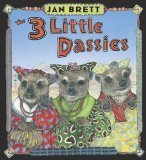 3 LITTLE DASSIES by Jan Brett (Putnam, 2010)
3 LITTLE DASSIES by Jan Brett (Putnam, 2010)
Inspired by a visit to Namibia in Southern Africa, three little groundhog-meets-koala-like creatures build their houses of driftwood, grasses and rocks while an eagle with young to feed looks on hungrily in this Three Pigs take-off. Amazing textile patterns and signature borders and frames delicately decorated with native patterns and samples from nature are especially graceful and dynamic, even for Brett's consistently detailed body of work. The debonair and gallant Agama Man (a lizard), happy to have new neighbors, adds a new dimension of drama as he rescues the two terrified dassie sisters while the third fights off their enemy. Packed with eyebrow-raising excitement, this beautiful book emanates and inspires respect and awe for the African landscape, and ends with a pourquoi-tale twist that brings the fanciful story back around to the real world, with a symbiotic relationship between dassies, agama and the black-feathered eagles. This book reads like a treasure-box collected from travel, and is well worth the trip. (5 and up)
Links are provided for informational use. Don't forget to support your local bookseller.
More Esmé stuff at www.planetesme.com.


 CLEVER JACK TAKES THE CAKE by Candace Fleming, illustrated by G. Brian Karas (Schwartz & Wade, 2010)
CLEVER JACK TAKES THE CAKE by Candace Fleming, illustrated by G. Brian Karas (Schwartz & Wade, 2010)
Jack is bringing a gift to the princess for her birthday, and he has it all planned out. Even though he's broke, he's going to make the best with what he has.
And that same mornning, he traded his ax for two bags of sugar, and his quilt for a sack of flour. He gave the hen an extra handful of seed in exchange for two fresh eggs, and he kissed the cow on the nose for a pail of her sweetest milk. He gathered walnuts. He dipped candles. And in the strawberry patch he searched…and searched…and searched until he found the reddest, juiciest, most succulent strawberry in all the land. "Delicious!" said Jack as he plucked it from its stem.Wah-lah, all the ingredients for a perfect cake, with "princess" spelled out in walnuts, and away sets Jack for the castle, only to be hindered by four-and-twenty blackbirds, an ogre with a sweet tooth, a dark forest, a hungry dancing bear and a castle guard who informs him that the princess is allergic to strawberries. Finding himself at the front of the royal receiving line, what does Jack have left to give? A story of course, and one that knocks the princess' royal socks off.

 Candace Fleming is crazy versatile in her gift for writing, penning ambitious and well-researched historical nonfiction for kids (check out BEN FRANKLIN'S ALMANAC
Candace Fleming is crazy versatile in her gift for writing, penning ambitious and well-researched historical nonfiction for kids (check out BEN FRANKLIN'S ALMANAC , THE LINCOLNS
, THE LINCOLNS or my personal favorite, A BIG CHEESE IN THE WHITE HOUSE: THE TRUE TALE OF A TREMENDOUS CHEDDAR
or my personal favorite, A BIG CHEESE IN THE WHITE HOUSE: THE TRUE TALE OF A TREMENDOUS CHEDDAR ), picture books (like the clever and popular MUNCHA, MUNCHA, MUNCHA
), picture books (like the clever and popular MUNCHA, MUNCHA, MUNCHA ,
, done in collaboration with this same illustrator), a besides her special penchant for the historical, she has a flair for the folkloric (case in point: THE FABLED FOURTH GRADERS OF AESOP ELEMENTARY
done in collaboration with this same illustrator), a besides her special penchant for the historical, she has a flair for the folkloric (case in point: THE FABLED FOURTH GRADERS OF AESOP ELEMENTARY , which has a sequel, THE FABLED FIFTH GRADERS
, which has a sequel, THE FABLED FIFTH GRADERS ), proving she can juggle genres with the aplomb of the great Avi. But though all her books are consistently special, there is something especially flawless in this one, a chef d'oeuvre of sorts, even on an already heavy shelf of accomplishment. Her equally prolific illustrator, using his standard charming colored pencil and watercolor technique, has stepped up his game here, starting on the endpapers with a black cloud of foreboding forest and an almost romantic moonlit chat between the princess and Jack awaiting on the other side, with exciting variation of layout in between.
), proving she can juggle genres with the aplomb of the great Avi. But though all her books are consistently special, there is something especially flawless in this one, a chef d'oeuvre of sorts, even on an already heavy shelf of accomplishment. Her equally prolific illustrator, using his standard charming colored pencil and watercolor technique, has stepped up his game here, starting on the endpapers with a black cloud of foreboding forest and an almost romantic moonlit chat between the princess and Jack awaiting on the other side, with exciting variation of layout in between.  Besides being a perfect marriage of text and art, this deceptively simple book is a pretty flawless read-aloud, inviting both attention and participation from the listener and should be a contender for the Geisel Award. It belongs on every child's shelf, and is a must-have for starting fairy tale units and a sure-fire "read it again!" choice for the lap or the nap. Sweet and with just the right mix of storytime ingredients, just like a good cake, it rises to the occasion. (5 and up)
Besides being a perfect marriage of text and art, this deceptively simple book is a pretty flawless read-aloud, inviting both attention and participation from the listener and should be a contender for the Geisel Award. It belongs on every child's shelf, and is a must-have for starting fairy tale units and a sure-fire "read it again!" choice for the lap or the nap. Sweet and with just the right mix of storytime ingredients, just like a good cake, it rises to the occasion. (5 and up)Also of interest:Another fresh nursery-tale take!
 3 LITTLE DASSIES by Jan Brett (Putnam, 2010)
3 LITTLE DASSIES by Jan Brett (Putnam, 2010)
Inspired by a visit to Namibia in Southern Africa, three little groundhog-meets-koala-like creatures build their houses of driftwood, grasses and rocks while an eagle with young to feed looks on hungrily in this Three Pigs take-off. Amazing textile patterns and signature borders and frames delicately decorated with native patterns and samples from nature are especially graceful and dynamic, even for Brett's consistently detailed body of work. The debonair and gallant Agama Man (a lizard), happy to have new neighbors, adds a new dimension of drama as he rescues the two terrified dassie sisters while the third fights off their enemy. Packed with eyebrow-raising excitement, this beautiful book emanates and inspires respect and awe for the African landscape, and ends with a pourquoi-tale twist that brings the fanciful story back around to the real world, with a symbiotic relationship between dassies, agama and the black-feathered eagles. This book reads like a treasure-box collected from travel, and is well worth the trip. (5 and up)
Links are provided for informational use. Don't forget to support your local bookseller.
More Esmé stuff at www.planetesme.com.
Published on December 30, 2010 05:34
December 1, 2010
DOTTY (PICTURE BOOK)
PICTURE BOOK
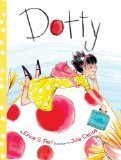 DOTTY by Erica S. Perl, illustrated by Julia Denos (Abrams)
DOTTY by Erica S. Perl, illustrated by Julia Denos (Abrams)
Sometimes there comes a book that undermines any hope I could have of descriptive prowess and just sends me reeling into a repeating chorus of PERFECT PERFECT PERFECT PERFECT PERFECT PERFECT PERFECT PERFECT PERFECT PERFECT PERFECT! Oh my shelves, this is why you were built, let me put this on you and take it off again and again to see if it STILL makes me cry with each new reading, why YES IT DOES! Pardon my lack of decorum but my goodness, teachers certainly read a lot of books and it absolutely rattles the marrow to find one that "gets it" so 110%, one written with such a sense of surprise and real love, and one that so freshly suggests growing up is not necessarily about letting go, but about holding on with grace; a great message both for little people and the big people who share with them. Loose, lively, largely ink illustrations are very colorful and expressive, and manage the tricky realistic and the otherworldly dichotomy here. Do you still have what you imagine in your pocket, or on a long blue leash? Not since Margery Williams' THE VELVETEEN RABBIT

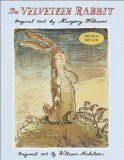 has a book said something been spoken so truly about the happy and sad of the nature of things being "real." If there is a teacher or a child you like at all, please share this book with them, along with a very real hug. (6 and up)
has a book said something been spoken so truly about the happy and sad of the nature of things being "real." If there is a teacher or a child you like at all, please share this book with them, along with a very real hug. (6 and up)
Also of interest: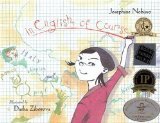
 IN ENGLISH, OF COURSE by Josephine Nobisso, illustrated by Dasha Ziborova (Gingerbread House, 2003)
IN ENGLISH, OF COURSE by Josephine Nobisso, illustrated by Dasha Ziborova (Gingerbread House, 2003) The members of Josephine's classroom all seem to come from somewhere else, and are called upon in turn to talk about where their families are from. But when it's Josephine's turn, she is not sure she has enough English under her belt to explain that her parents are architectural engineers from Napoli, Italy. Her limited language leads her into uncharted farm territory, where with the help of her teacher she is able to share an extravagant reminiscence about a cow, told with a lot of body language. This hilarious and honest book explores both the insides and the outsides of an extremely intelligent child who is just gathering the tools she needs to make herself understood. The splashy collage illustrations appropriately reflect the wild amounts of information that are being sorted through, along with the style and spirit of the story's heroine. ESL students and teachers will cheer here, but any child will empathize with Josephine's earnest attempt to share the best of herself with her class. "Sometimes native-speaking people underestimate the talents, dignity and wit of newcomers to a country," the author muses in her postscript. All of these attributes come through loud and clear in one of the more endearing characters and accurate classroom narratives to appear in children's literature (6 and up)
The members of Josephine's classroom all seem to come from somewhere else, and are called upon in turn to talk about where their families are from. But when it's Josephine's turn, she is not sure she has enough English under her belt to explain that her parents are architectural engineers from Napoli, Italy. Her limited language leads her into uncharted farm territory, where with the help of her teacher she is able to share an extravagant reminiscence about a cow, told with a lot of body language. This hilarious and honest book explores both the insides and the outsides of an extremely intelligent child who is just gathering the tools she needs to make herself understood. The splashy collage illustrations appropriately reflect the wild amounts of information that are being sorted through, along with the style and spirit of the story's heroine. ESL students and teachers will cheer here, but any child will empathize with Josephine's earnest attempt to share the best of herself with her class. "Sometimes native-speaking people underestimate the talents, dignity and wit of newcomers to a country," the author muses in her postscript. All of these attributes come through loud and clear in one of the more endearing characters and accurate classroom narratives to appear in children's literature (6 and up)
Links are provided for informational use. Don't forget to support your local bookseller.
More Esmé stuff at www.planetesme.com.

 DOTTY by Erica S. Perl, illustrated by Julia Denos (Abrams)
DOTTY by Erica S. Perl, illustrated by Julia Denos (Abrams)"Where's Keeko?" she asked.When Ida goes to school, she brings her imaginary friend Dotty with her, and it turns out that the classroom is populated with plenty of such companions. But as time passes, these partnerships dissipate, and Ida is stigmatized. All the same, she is not yet willing to say goodbye, Dotty being so very real to her in spite of what other people see. Only after a very poignant talk with her empathetic teacher is Ida able to loosen the leash on her pet, her own pedagogue proving that you don't need to let go of the best parts of your imagination in order to carry on into the world of grown-ups.
"Ida!" scolded Katya. "That's for babies." She looked around, then whispered, "I still keep her in my pocket sometimes."
With a laugh, Katya ran off. Ida chased after her.
Dotty tried to catch up, but the snow made it hard.
Sometimes there comes a book that undermines any hope I could have of descriptive prowess and just sends me reeling into a repeating chorus of PERFECT PERFECT PERFECT PERFECT PERFECT PERFECT PERFECT PERFECT PERFECT PERFECT PERFECT! Oh my shelves, this is why you were built, let me put this on you and take it off again and again to see if it STILL makes me cry with each new reading, why YES IT DOES! Pardon my lack of decorum but my goodness, teachers certainly read a lot of books and it absolutely rattles the marrow to find one that "gets it" so 110%, one written with such a sense of surprise and real love, and one that so freshly suggests growing up is not necessarily about letting go, but about holding on with grace; a great message both for little people and the big people who share with them. Loose, lively, largely ink illustrations are very colorful and expressive, and manage the tricky realistic and the otherworldly dichotomy here. Do you still have what you imagine in your pocket, or on a long blue leash? Not since Margery Williams' THE VELVETEEN RABBIT


 has a book said something been spoken so truly about the happy and sad of the nature of things being "real." If there is a teacher or a child you like at all, please share this book with them, along with a very real hug. (6 and up)
has a book said something been spoken so truly about the happy and sad of the nature of things being "real." If there is a teacher or a child you like at all, please share this book with them, along with a very real hug. (6 and up)Also of interest:

 IN ENGLISH, OF COURSE by Josephine Nobisso, illustrated by Dasha Ziborova (Gingerbread House, 2003)
IN ENGLISH, OF COURSE by Josephine Nobisso, illustrated by Dasha Ziborova (Gingerbread House, 2003) The members of Josephine's classroom all seem to come from somewhere else, and are called upon in turn to talk about where their families are from. But when it's Josephine's turn, she is not sure she has enough English under her belt to explain that her parents are architectural engineers from Napoli, Italy. Her limited language leads her into uncharted farm territory, where with the help of her teacher she is able to share an extravagant reminiscence about a cow, told with a lot of body language. This hilarious and honest book explores both the insides and the outsides of an extremely intelligent child who is just gathering the tools she needs to make herself understood. The splashy collage illustrations appropriately reflect the wild amounts of information that are being sorted through, along with the style and spirit of the story's heroine. ESL students and teachers will cheer here, but any child will empathize with Josephine's earnest attempt to share the best of herself with her class. "Sometimes native-speaking people underestimate the talents, dignity and wit of newcomers to a country," the author muses in her postscript. All of these attributes come through loud and clear in one of the more endearing characters and accurate classroom narratives to appear in children's literature (6 and up)
The members of Josephine's classroom all seem to come from somewhere else, and are called upon in turn to talk about where their families are from. But when it's Josephine's turn, she is not sure she has enough English under her belt to explain that her parents are architectural engineers from Napoli, Italy. Her limited language leads her into uncharted farm territory, where with the help of her teacher she is able to share an extravagant reminiscence about a cow, told with a lot of body language. This hilarious and honest book explores both the insides and the outsides of an extremely intelligent child who is just gathering the tools she needs to make herself understood. The splashy collage illustrations appropriately reflect the wild amounts of information that are being sorted through, along with the style and spirit of the story's heroine. ESL students and teachers will cheer here, but any child will empathize with Josephine's earnest attempt to share the best of herself with her class. "Sometimes native-speaking people underestimate the talents, dignity and wit of newcomers to a country," the author muses in her postscript. All of these attributes come through loud and clear in one of the more endearing characters and accurate classroom narratives to appear in children's literature (6 and up) Links are provided for informational use. Don't forget to support your local bookseller.
More Esmé stuff at www.planetesme.com.
Published on December 01, 2010 15:05
November 22, 2010
I FEEL BETTER WITH A FROG IN MY THROAT (NONFICTION)
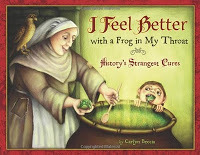 NONFICTION
NONFICTIONWow, a lot of cold and flu going around. Time for a reading prescription.
I FEEL BETTER WITH A FROG IN MY THROAT
 by Caralyn Becker (Houghton Mifflin) Which is the surest cure for a wound: honey, moldy bread, puppy kisses, spider webs or maggots? All of these prescriptions were employed at some point in history. Millipedes were used for stomachaches, holes drilled in the head for migraines, and necklaces were made of earthworms for sore throats, all with varying degrees of success starting with zero. What fun, in multiple choice format, to discover the surprising answers of which alchemy rated an A+. Well written in an inviting conversational style, the text is enhanced with humorous digital mixed media illustrations that suggest rich paintings with tongue applied firmly in cheek. Following up on her unusual and enticing children's nonfiction such as WHO PUT THE B IN BALLYHOO
by Caralyn Becker (Houghton Mifflin) Which is the surest cure for a wound: honey, moldy bread, puppy kisses, spider webs or maggots? All of these prescriptions were employed at some point in history. Millipedes were used for stomachaches, holes drilled in the head for migraines, and necklaces were made of earthworms for sore throats, all with varying degrees of success starting with zero. What fun, in multiple choice format, to discover the surprising answers of which alchemy rated an A+. Well written in an inviting conversational style, the text is enhanced with humorous digital mixed media illustrations that suggest rich paintings with tongue applied firmly in cheek. Following up on her unusual and enticing children's nonfiction such as WHO PUT THE B IN BALLYHOO and THE RAUCOUS ROYALS
and THE RAUCOUS ROYALS , likewise, this well-researched, bibliography-backed volume doesn't flinch as it conveys the finer, funnier and freakier details of history. A picture book boon for older children, this doubles most definitely as a sure cure for reluctant readers. (8 and up)
, likewise, this well-researched, bibliography-backed volume doesn't flinch as it conveys the finer, funnier and freakier details of history. A picture book boon for older children, this doubles most definitely as a sure cure for reluctant readers. (8 and up)Also of interest:
 A SICK DAY FOR AMOS MCGEE
A SICK DAY FOR AMOS MCGEE by Philip C. Stead, illustrated by Erin E. Stead (Roaring Brook)
by Philip C. Stead, illustrated by Erin E. Stead (Roaring Brook) Zookeeper Amos takes mighty good care of his friends. Every day, He plays chess with the elephant, races the tortoise (and lets him win), wipes the rhinoceros' substantial runny nose, keeps a shy penguin company and reads to the night owl who is afraid of the dark. But when Amos gets sick with the flu, it's the animals who come and deliver the necessary caretaking. Such zoo-in-the-home stories have a long line of grandparents, from A ZOO FOR MISTER MUSTER
Zookeeper Amos takes mighty good care of his friends. Every day, He plays chess with the elephant, races the tortoise (and lets him win), wipes the rhinoceros' substantial runny nose, keeps a shy penguin company and reads to the night owl who is afraid of the dark. But when Amos gets sick with the flu, it's the animals who come and deliver the necessary caretaking. Such zoo-in-the-home stories have a long line of grandparents, from A ZOO FOR MISTER MUSTER by Arnold Lobel (1962) to Peggy Rathmann's inimitable GOOD NIGHT, GORILLA
by Arnold Lobel (1962) to Peggy Rathmann's inimitable GOOD NIGHT, GORILLA (1994), visually referenced in Stead's illustrations with a familiar red balloon and tiny supporting-character mouse making several appearances throughout. This book has a sensitive pencil line and woodblock backdrops, and a muted, restrained palette that is rare these days, understated and lovely. Just like the kind of man Amos reveals himself to be, unafraid of being kind and soft, the great strength of this book is in its brave gentleness. Look at that mighty elephant trunk curled carefully around the wing of a penguin, animals patiently waiting at the stop for a public bus, or Amos playing hide-and-seek under a peacock-patterned coverlet! An excellent friendship story hinging on the underserved but important theme of reciprocation, it goes to show another day at the zoo is always welcome. (4 and up)
(1994), visually referenced in Stead's illustrations with a familiar red balloon and tiny supporting-character mouse making several appearances throughout. This book has a sensitive pencil line and woodblock backdrops, and a muted, restrained palette that is rare these days, understated and lovely. Just like the kind of man Amos reveals himself to be, unafraid of being kind and soft, the great strength of this book is in its brave gentleness. Look at that mighty elephant trunk curled carefully around the wing of a penguin, animals patiently waiting at the stop for a public bus, or Amos playing hide-and-seek under a peacock-patterned coverlet! An excellent friendship story hinging on the underserved but important theme of reciprocation, it goes to show another day at the zoo is always welcome. (4 and up)Links are provided for informational use. Don't forget to support your local bookseller.
More Esmé stuff at www.planetesme.com.
Published on November 22, 2010 20:56
November 12, 2010
MIRROR (PICTURE BOOK)
PICTURE BOOK
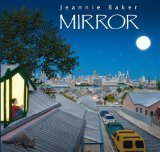 MIRROR by Jeannie Baker (Candlewick, 2010)
MIRROR by Jeannie Baker (Candlewick, 2010)
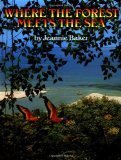 Jeannie Baker is a seasoned children's book illustrator (some teachers may recognize her earlier work, WHERE THE FOREST MEETS THE SEA
Jeannie Baker is a seasoned children's book illustrator (some teachers may recognize her earlier work, WHERE THE FOREST MEETS THE SEA  from rainforest units). I hope it can be appreciated what a major, major undertaking this latest work must have been. Even the conception of the project, requiring some reader acrobatics decoding narratives in two different directions, literally and figuratively, redefines in some way the structure and expectation of a book. The wordless text gives the story universality, with a storyline intended clearly to unify, while never sacrificing the cultural integrity of each country represented. But whoooosh, look at that art, meticulous paper cut and collage on every page, integrating sand, tin, wood, plastic, clay, paint and vegetation. The whole world seems in this book, and fittingly so; most of all, this is a book about love of the world, in it's sameness and its differences. It doesn't require us to believe everyone is "just like us" in order for us to love them and want them to be free. At the same time, the book allows us to notice our commonalities in a real world context. The story ends with the Australian boy's imagination being lifted by thoughts of a "magic carpet" imported to and bought at the hardware store, while the Moroccan family is swept away by their own market purchase: a desktop computer. It is interesting she chose to end on that note, albeit subtle, where the Westernized family is still holding to outdated stereotypes of the Arab world, while the other family, for all the isolation of the landscape, is moving forward toward the technological age; but rather than reading as an accusation, it comes off as an invitation to an updated global view. Teachers, students can research other countries and cultures to create a similar parallel illustration, a picture that tells a thousand words.
from rainforest units). I hope it can be appreciated what a major, major undertaking this latest work must have been. Even the conception of the project, requiring some reader acrobatics decoding narratives in two different directions, literally and figuratively, redefines in some way the structure and expectation of a book. The wordless text gives the story universality, with a storyline intended clearly to unify, while never sacrificing the cultural integrity of each country represented. But whoooosh, look at that art, meticulous paper cut and collage on every page, integrating sand, tin, wood, plastic, clay, paint and vegetation. The whole world seems in this book, and fittingly so; most of all, this is a book about love of the world, in it's sameness and its differences. It doesn't require us to believe everyone is "just like us" in order for us to love them and want them to be free. At the same time, the book allows us to notice our commonalities in a real world context. The story ends with the Australian boy's imagination being lifted by thoughts of a "magic carpet" imported to and bought at the hardware store, while the Moroccan family is swept away by their own market purchase: a desktop computer. It is interesting she chose to end on that note, albeit subtle, where the Westernized family is still holding to outdated stereotypes of the Arab world, while the other family, for all the isolation of the landscape, is moving forward toward the technological age; but rather than reading as an accusation, it comes off as an invitation to an updated global view. Teachers, students can research other countries and cultures to create a similar parallel illustration, a picture that tells a thousand words.
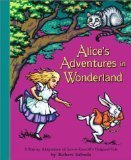 In a world of electronic beeping and booping, buttons to press and glowing screens, this is a straight-up analog book for the 21st century. It deserves way more buzz than it has been getting, and though the author's nationality might get it tripped up on the residency criteria of "most distinguished contribution to American literature," I hope the award committees are on the alert for how to give this American edition its due in the states; it reminds me of the year Robert Sabuda created his first big pop-up, ALICE'S ADVENTURES IN WONDERLAND
In a world of electronic beeping and booping, buttons to press and glowing screens, this is a straight-up analog book for the 21st century. It deserves way more buzz than it has been getting, and though the author's nationality might get it tripped up on the residency criteria of "most distinguished contribution to American literature," I hope the award committees are on the alert for how to give this American edition its due in the states; it reminds me of the year Robert Sabuda created his first big pop-up, ALICE'S ADVENTURES IN WONDERLAND

 , requiring hundreds of hand-carved block plates and probably deserving of a Caledott and a half, but might have been considered a "novelty book." Please pay attention, ya'll. (7 and up)
, requiring hundreds of hand-carved block plates and probably deserving of a Caledott and a half, but might have been considered a "novelty book." Please pay attention, ya'll. (7 and up)
Also of interest:They say a journey of a thousand miles begins with a single step. It can begin with a single page, too! Encourage your young readers to atke a trip around the world by exploring titles on the "Book a Trip Around the World" list, here! Teachers, make passports with a page for every continent, and rubberstamp pages as they read books from particular locales. How far can children travel with books?
Links are provided for informational use. Don't forget to support your local bookseller.
More Esmé stuff at www.planetesme.com.

 MIRROR by Jeannie Baker (Candlewick, 2010)
MIRROR by Jeannie Baker (Candlewick, 2010)
"The idea for this book came from my delight traveling in a country very different from my own. At the time, in my own country, there was much political poisoning of attitudes of foreigners and foreignness. But traveling along in remote Morocco, a woman 'stranger' myself, I was met with much friendliness and generosity from 'strangers.' The idea for the book was right there: that outward appearances may be very different but the inner person of a 'stranger' may not be a stranger at all. Like each other, we live to be loved by family and friends and to be a part of a larger family, a community. Inwardly we are so alike, it could be each other we see when we look in a mirror."- Jeannie BakerGet ready for something out of the children's book "box." Two parallel stories of two families: one in urban Australia, one in Morocco. When you open the single book, two bound texts are revealed, one on the front side of the binding and one on the backside, one you follow right to left, the other, left to right, in mirror image, with pages to be turned at the same time. In this way, we go wordlessly through an average day for both families, both involving shopping, one side featuring a boy's trip to the mega hardware store in a shopping mall, the other to a sandy desert market. Not since Mistumasa Anno's ALL IN A DAY has parallel timelines gotten such unusual play.
 Jeannie Baker is a seasoned children's book illustrator (some teachers may recognize her earlier work, WHERE THE FOREST MEETS THE SEA
Jeannie Baker is a seasoned children's book illustrator (some teachers may recognize her earlier work, WHERE THE FOREST MEETS THE SEA  from rainforest units). I hope it can be appreciated what a major, major undertaking this latest work must have been. Even the conception of the project, requiring some reader acrobatics decoding narratives in two different directions, literally and figuratively, redefines in some way the structure and expectation of a book. The wordless text gives the story universality, with a storyline intended clearly to unify, while never sacrificing the cultural integrity of each country represented. But whoooosh, look at that art, meticulous paper cut and collage on every page, integrating sand, tin, wood, plastic, clay, paint and vegetation. The whole world seems in this book, and fittingly so; most of all, this is a book about love of the world, in it's sameness and its differences. It doesn't require us to believe everyone is "just like us" in order for us to love them and want them to be free. At the same time, the book allows us to notice our commonalities in a real world context. The story ends with the Australian boy's imagination being lifted by thoughts of a "magic carpet" imported to and bought at the hardware store, while the Moroccan family is swept away by their own market purchase: a desktop computer. It is interesting she chose to end on that note, albeit subtle, where the Westernized family is still holding to outdated stereotypes of the Arab world, while the other family, for all the isolation of the landscape, is moving forward toward the technological age; but rather than reading as an accusation, it comes off as an invitation to an updated global view. Teachers, students can research other countries and cultures to create a similar parallel illustration, a picture that tells a thousand words.
from rainforest units). I hope it can be appreciated what a major, major undertaking this latest work must have been. Even the conception of the project, requiring some reader acrobatics decoding narratives in two different directions, literally and figuratively, redefines in some way the structure and expectation of a book. The wordless text gives the story universality, with a storyline intended clearly to unify, while never sacrificing the cultural integrity of each country represented. But whoooosh, look at that art, meticulous paper cut and collage on every page, integrating sand, tin, wood, plastic, clay, paint and vegetation. The whole world seems in this book, and fittingly so; most of all, this is a book about love of the world, in it's sameness and its differences. It doesn't require us to believe everyone is "just like us" in order for us to love them and want them to be free. At the same time, the book allows us to notice our commonalities in a real world context. The story ends with the Australian boy's imagination being lifted by thoughts of a "magic carpet" imported to and bought at the hardware store, while the Moroccan family is swept away by their own market purchase: a desktop computer. It is interesting she chose to end on that note, albeit subtle, where the Westernized family is still holding to outdated stereotypes of the Arab world, while the other family, for all the isolation of the landscape, is moving forward toward the technological age; but rather than reading as an accusation, it comes off as an invitation to an updated global view. Teachers, students can research other countries and cultures to create a similar parallel illustration, a picture that tells a thousand words. In a world of electronic beeping and booping, buttons to press and glowing screens, this is a straight-up analog book for the 21st century. It deserves way more buzz than it has been getting, and though the author's nationality might get it tripped up on the residency criteria of "most distinguished contribution to American literature," I hope the award committees are on the alert for how to give this American edition its due in the states; it reminds me of the year Robert Sabuda created his first big pop-up, ALICE'S ADVENTURES IN WONDERLAND
In a world of electronic beeping and booping, buttons to press and glowing screens, this is a straight-up analog book for the 21st century. It deserves way more buzz than it has been getting, and though the author's nationality might get it tripped up on the residency criteria of "most distinguished contribution to American literature," I hope the award committees are on the alert for how to give this American edition its due in the states; it reminds me of the year Robert Sabuda created his first big pop-up, ALICE'S ADVENTURES IN WONDERLAND

 , requiring hundreds of hand-carved block plates and probably deserving of a Caledott and a half, but might have been considered a "novelty book." Please pay attention, ya'll. (7 and up)
, requiring hundreds of hand-carved block plates and probably deserving of a Caledott and a half, but might have been considered a "novelty book." Please pay attention, ya'll. (7 and up)Also of interest:They say a journey of a thousand miles begins with a single step. It can begin with a single page, too! Encourage your young readers to atke a trip around the world by exploring titles on the "Book a Trip Around the World" list, here! Teachers, make passports with a page for every continent, and rubberstamp pages as they read books from particular locales. How far can children travel with books?
Links are provided for informational use. Don't forget to support your local bookseller.
More Esmé stuff at www.planetesme.com.
Published on November 12, 2010 04:59
November 7, 2010
STAND STRAIGHT, ELLA KATE (NONFICTION)
NONFICTION
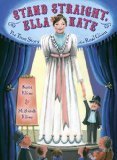
 STAND STRAIGHT, ELLA KATE by Kate Klise and M. Sarah Klise (Dial, 2010)
STAND STRAIGHT, ELLA KATE by Kate Klise and M. Sarah Klise (Dial, 2010) Little Ella Kate Eming didn't stay little for long. Due to a gland disorder that was poorly understood by the doctors of the late nineteenth century, she sprouted up like the tallest sunflower, ultimately over eight feet. In her small town in Missouri, she was able to find friends and had parents who cared for her dearly, building her a special desk for school, hemming her dresses longer and longer, and always advising her to "stand straight" instead of hiding her difference. All the same, some painful teasing makes it so she stays close to home. When a man from a museum approaches her with an unusual gig, will she cower or come into the spotlight? One of the most heartwarming parts of the story is when Ella Kate can finally afford to build a house to her specifications, and can really be at home, in her own place and her own body. First-person narrative helps to bring Ella Kate to life, and makes all the more palpable the pain of the moniker of "freak," but also makes her victories glow all the more brightly, a woman who traveled, earned money and had great and unique adventures when few opportunities were available to women of any size. The matte acrylic illustrations are folksy but still manage great feeling, with varied layouts that maintain interest and compliment the action throughout. This is a book about a true hero, inspiration and rare spirit, executed with a great and contagious affection and admiration for its subject. What child doesn't feel different in some way, and wouldn't be fortified by such a story? Read this, and you'll be standing straight for an ovation for a truly outstanding picture book biography. (7 and up)
Little Ella Kate Eming didn't stay little for long. Due to a gland disorder that was poorly understood by the doctors of the late nineteenth century, she sprouted up like the tallest sunflower, ultimately over eight feet. In her small town in Missouri, she was able to find friends and had parents who cared for her dearly, building her a special desk for school, hemming her dresses longer and longer, and always advising her to "stand straight" instead of hiding her difference. All the same, some painful teasing makes it so she stays close to home. When a man from a museum approaches her with an unusual gig, will she cower or come into the spotlight? One of the most heartwarming parts of the story is when Ella Kate can finally afford to build a house to her specifications, and can really be at home, in her own place and her own body. First-person narrative helps to bring Ella Kate to life, and makes all the more palpable the pain of the moniker of "freak," but also makes her victories glow all the more brightly, a woman who traveled, earned money and had great and unique adventures when few opportunities were available to women of any size. The matte acrylic illustrations are folksy but still manage great feeling, with varied layouts that maintain interest and compliment the action throughout. This is a book about a true hero, inspiration and rare spirit, executed with a great and contagious affection and admiration for its subject. What child doesn't feel different in some way, and wouldn't be fortified by such a story? Read this, and you'll be standing straight for an ovation for a truly outstanding picture book biography. (7 and up)
Also of interest: TOM THUMB: THE REMARKABLE TRUE STORY OF A MAN IN MINIATURE by George Sullivan (Clarion, 2011)Step right up, and see the four-year-old Charles Stratton, two feet tall and fifteen pounds, same as he was as a seven-month-old baby. Master promoter P.T. Barnum didn't miss a beat when it came to recruiting Charles for his circus, making him very rich, awfully famous, and a symbiotic partner in Barnum's travels and adventures. While it is hard to conceive of the relationship as anything but exploitative, the author does a commendable job at the task of truly putting Stratton's position in the historical context of the 19th century, where life was difficult and often sad, and entertainment a rare commodity; "Tom Thumb" was an early modern celebrity. Lots of text is made palpable for young readers by virtue of wide leading (space) between the lines, and the scrapbook-like interspersion of photographs and ephemera, including etchings of Sullivan's visit to the queen, and pictures of his bride Lavinia Bump and his other circus friends. Pages of source notes underscore primary sources, and a generous bibliography is also included. Interesting reading, sure to provoke discussion, and besides being an appealing choice for reluctant readers poring over the nonfiction shelves, this is an excellent pick for book clubs looking for a true story. (8 and up)
TOM THUMB: THE REMARKABLE TRUE STORY OF A MAN IN MINIATURE by George Sullivan (Clarion, 2011)Step right up, and see the four-year-old Charles Stratton, two feet tall and fifteen pounds, same as he was as a seven-month-old baby. Master promoter P.T. Barnum didn't miss a beat when it came to recruiting Charles for his circus, making him very rich, awfully famous, and a symbiotic partner in Barnum's travels and adventures. While it is hard to conceive of the relationship as anything but exploitative, the author does a commendable job at the task of truly putting Stratton's position in the historical context of the 19th century, where life was difficult and often sad, and entertainment a rare commodity; "Tom Thumb" was an early modern celebrity. Lots of text is made palpable for young readers by virtue of wide leading (space) between the lines, and the scrapbook-like interspersion of photographs and ephemera, including etchings of Sullivan's visit to the queen, and pictures of his bride Lavinia Bump and his other circus friends. Pages of source notes underscore primary sources, and a generous bibliography is also included. Interesting reading, sure to provoke discussion, and besides being an appealing choice for reluctant readers poring over the nonfiction shelves, this is an excellent pick for book clubs looking for a true story. (8 and up)
Links are provided for informational use. Don't forget to support your local bookseller.
More Esmé stuff at www.planetesme.com.


 STAND STRAIGHT, ELLA KATE by Kate Klise and M. Sarah Klise (Dial, 2010)
STAND STRAIGHT, ELLA KATE by Kate Klise and M. Sarah Klise (Dial, 2010) Little Ella Kate Eming didn't stay little for long. Due to a gland disorder that was poorly understood by the doctors of the late nineteenth century, she sprouted up like the tallest sunflower, ultimately over eight feet. In her small town in Missouri, she was able to find friends and had parents who cared for her dearly, building her a special desk for school, hemming her dresses longer and longer, and always advising her to "stand straight" instead of hiding her difference. All the same, some painful teasing makes it so she stays close to home. When a man from a museum approaches her with an unusual gig, will she cower or come into the spotlight? One of the most heartwarming parts of the story is when Ella Kate can finally afford to build a house to her specifications, and can really be at home, in her own place and her own body. First-person narrative helps to bring Ella Kate to life, and makes all the more palpable the pain of the moniker of "freak," but also makes her victories glow all the more brightly, a woman who traveled, earned money and had great and unique adventures when few opportunities were available to women of any size. The matte acrylic illustrations are folksy but still manage great feeling, with varied layouts that maintain interest and compliment the action throughout. This is a book about a true hero, inspiration and rare spirit, executed with a great and contagious affection and admiration for its subject. What child doesn't feel different in some way, and wouldn't be fortified by such a story? Read this, and you'll be standing straight for an ovation for a truly outstanding picture book biography. (7 and up)
Little Ella Kate Eming didn't stay little for long. Due to a gland disorder that was poorly understood by the doctors of the late nineteenth century, she sprouted up like the tallest sunflower, ultimately over eight feet. In her small town in Missouri, she was able to find friends and had parents who cared for her dearly, building her a special desk for school, hemming her dresses longer and longer, and always advising her to "stand straight" instead of hiding her difference. All the same, some painful teasing makes it so she stays close to home. When a man from a museum approaches her with an unusual gig, will she cower or come into the spotlight? One of the most heartwarming parts of the story is when Ella Kate can finally afford to build a house to her specifications, and can really be at home, in her own place and her own body. First-person narrative helps to bring Ella Kate to life, and makes all the more palpable the pain of the moniker of "freak," but also makes her victories glow all the more brightly, a woman who traveled, earned money and had great and unique adventures when few opportunities were available to women of any size. The matte acrylic illustrations are folksy but still manage great feeling, with varied layouts that maintain interest and compliment the action throughout. This is a book about a true hero, inspiration and rare spirit, executed with a great and contagious affection and admiration for its subject. What child doesn't feel different in some way, and wouldn't be fortified by such a story? Read this, and you'll be standing straight for an ovation for a truly outstanding picture book biography. (7 and up)Also of interest:
 TOM THUMB: THE REMARKABLE TRUE STORY OF A MAN IN MINIATURE by George Sullivan (Clarion, 2011)Step right up, and see the four-year-old Charles Stratton, two feet tall and fifteen pounds, same as he was as a seven-month-old baby. Master promoter P.T. Barnum didn't miss a beat when it came to recruiting Charles for his circus, making him very rich, awfully famous, and a symbiotic partner in Barnum's travels and adventures. While it is hard to conceive of the relationship as anything but exploitative, the author does a commendable job at the task of truly putting Stratton's position in the historical context of the 19th century, where life was difficult and often sad, and entertainment a rare commodity; "Tom Thumb" was an early modern celebrity. Lots of text is made palpable for young readers by virtue of wide leading (space) between the lines, and the scrapbook-like interspersion of photographs and ephemera, including etchings of Sullivan's visit to the queen, and pictures of his bride Lavinia Bump and his other circus friends. Pages of source notes underscore primary sources, and a generous bibliography is also included. Interesting reading, sure to provoke discussion, and besides being an appealing choice for reluctant readers poring over the nonfiction shelves, this is an excellent pick for book clubs looking for a true story. (8 and up)
TOM THUMB: THE REMARKABLE TRUE STORY OF A MAN IN MINIATURE by George Sullivan (Clarion, 2011)Step right up, and see the four-year-old Charles Stratton, two feet tall and fifteen pounds, same as he was as a seven-month-old baby. Master promoter P.T. Barnum didn't miss a beat when it came to recruiting Charles for his circus, making him very rich, awfully famous, and a symbiotic partner in Barnum's travels and adventures. While it is hard to conceive of the relationship as anything but exploitative, the author does a commendable job at the task of truly putting Stratton's position in the historical context of the 19th century, where life was difficult and often sad, and entertainment a rare commodity; "Tom Thumb" was an early modern celebrity. Lots of text is made palpable for young readers by virtue of wide leading (space) between the lines, and the scrapbook-like interspersion of photographs and ephemera, including etchings of Sullivan's visit to the queen, and pictures of his bride Lavinia Bump and his other circus friends. Pages of source notes underscore primary sources, and a generous bibliography is also included. Interesting reading, sure to provoke discussion, and besides being an appealing choice for reluctant readers poring over the nonfiction shelves, this is an excellent pick for book clubs looking for a true story. (8 and up)Links are provided for informational use. Don't forget to support your local bookseller.
More Esmé stuff at www.planetesme.com.
Published on November 07, 2010 14:41
October 27, 2010
THE DARK EMPEROR AND OTHER POEMS OF THE NIGHT (POETRY)
POETRY
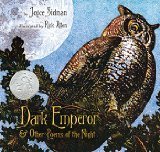
 THE DARK EMPEROR & OTHER POEMS OF THE NIGHT by Joyce Sidman, illustrated by Rick Allen (Houghton Mifflin)
THE DARK EMPEROR & OTHER POEMS OF THE NIGHT by Joyce Sidman, illustrated by Rick Allen (Houghton Mifflin)
Welcome, indeed, to page after page of the most striking hand-painted relief prints since the work of Christopher Wormell, decorated by pristine poetry (sigh to the ardency of the "Love Poem of the Primrose Moth," mind the "Night Spider's Advice" [ Do your work, then / sit back and see / what falls into your lap. / Eat your triumphs, / eat your mistakes…"] and amble along in jocular step with "I Am a Baby Porcupette"). From the loamy mushroom rot and curl of a forest underfoot to the swirl and swipe of bat's wings, croak of toads and crawl of efts, the book parlays back and forth between mysterious midnight spell a scientific explanation. While the somewhat bright azure background color conveys a mood that is not always shadowy enough for the subject, the full moon traverses the sky on every page and peeks out from between tree trunks, boughs and webs to remind us, this is night. These poems are the right size for a child's imagination, with succinct and elegant scientific explanations in the right-side columns anda nifty glossary to help young readers tackle words like "stridulation," "spinnerets" and "wane." Even after the closing of the book, the content spreads in the spirit like the lightening sky of day. A small epic to mood and beauty. (7 and up)
Also of interest: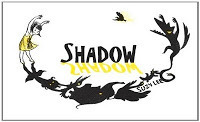
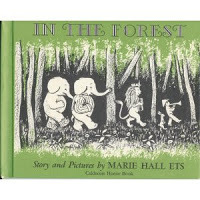 SHADOW by Suzy Lee (Chronicle)
SHADOW by Suzy Lee (Chronicle)  Well, well, well, here's one little girl who is NOT afraid of the dark. Turning on a naked lightbulb in a storage area, the ladder, vacuum, hose and various whatnots are transformed into wordless wonderland scenes that pull the character and the reader into a drama that grows more exciting with every turned page. Starting with Rorschach-like illustrations, reality rests on one side and a parallel, playful tropical/folkloric hybrid universe on the other, unified by the seam of the book. The imaginative world soon consumes both sides of the page as the girl defeats the small but nefarious wolf to a point of enough contrition that he is invited into a fantasy shindig. Dreams must be deferred when mother's call of "Dinner's ready!" cuts through the action like a scissors, perhaps a loose reference to the reassuring spell-breaking of Max's mother's soup in Sendak's WHERE THE WILD THINGS ARE
Well, well, well, here's one little girl who is NOT afraid of the dark. Turning on a naked lightbulb in a storage area, the ladder, vacuum, hose and various whatnots are transformed into wordless wonderland scenes that pull the character and the reader into a drama that grows more exciting with every turned page. Starting with Rorschach-like illustrations, reality rests on one side and a parallel, playful tropical/folkloric hybrid universe on the other, unified by the seam of the book. The imaginative world soon consumes both sides of the page as the girl defeats the small but nefarious wolf to a point of enough contrition that he is invited into a fantasy shindig. Dreams must be deferred when mother's call of "Dinner's ready!" cuts through the action like a scissors, perhaps a loose reference to the reassuring spell-breaking of Max's mother's soup in Sendak's WHERE THE WILD THINGS ARE . The room is left in disarray and darkness, but does that mean the party is really over? Like the little girl in the story, the artist does everything possible with what she's got: her limited palette of black and a spreading cloud of yellow, her simple stencils, her pencil, the very space on the page used with new energy and inventiveness. Stylistically, it is reminiscent of Marie Hall Ets' vintage IN THE FOREST
. The room is left in disarray and darkness, but does that mean the party is really over? Like the little girl in the story, the artist does everything possible with what she's got: her limited palette of black and a spreading cloud of yellow, her simple stencils, her pencil, the very space on the page used with new energy and inventiveness. Stylistically, it is reminiscent of Marie Hall Ets' vintage IN THE FOREST , but its fresh mastery of the form makes it a must-have for picture book lovers of all ages and if the illustrator were not residing in Singapore, this would be a Caldecott contender, beyond the shadow of a doubt. (4 and up)
, but its fresh mastery of the form makes it a must-have for picture book lovers of all ages and if the illustrator were not residing in Singapore, this would be a Caldecott contender, beyond the shadow of a doubt. (4 and up)
Links are provided for informational use. Don't forget to support your local bookseller.
More Esmé stuff at www.planetesme.com.


 THE DARK EMPEROR & OTHER POEMS OF THE NIGHT by Joyce Sidman, illustrated by Rick Allen (Houghton Mifflin)
THE DARK EMPEROR & OTHER POEMS OF THE NIGHT by Joyce Sidman, illustrated by Rick Allen (Houghton Mifflin)
To all of you who crawl and creep,
Who buzz and chirp and hoot and peep,
Who wake at dusk and throw off sleep;
Welcome to the night.
To you who make the forest sing,
Who dip and dodge on silent wing,
Who flutter, hover, clasp and cling:
Welcome to the night!...
Welcome, indeed, to page after page of the most striking hand-painted relief prints since the work of Christopher Wormell, decorated by pristine poetry (sigh to the ardency of the "Love Poem of the Primrose Moth," mind the "Night Spider's Advice" [ Do your work, then / sit back and see / what falls into your lap. / Eat your triumphs, / eat your mistakes…"] and amble along in jocular step with "I Am a Baby Porcupette"). From the loamy mushroom rot and curl of a forest underfoot to the swirl and swipe of bat's wings, croak of toads and crawl of efts, the book parlays back and forth between mysterious midnight spell a scientific explanation. While the somewhat bright azure background color conveys a mood that is not always shadowy enough for the subject, the full moon traverses the sky on every page and peeks out from between tree trunks, boughs and webs to remind us, this is night. These poems are the right size for a child's imagination, with succinct and elegant scientific explanations in the right-side columns anda nifty glossary to help young readers tackle words like "stridulation," "spinnerets" and "wane." Even after the closing of the book, the content spreads in the spirit like the lightening sky of day. A small epic to mood and beauty. (7 and up)
Also of interest:

 SHADOW by Suzy Lee (Chronicle)
SHADOW by Suzy Lee (Chronicle)  Well, well, well, here's one little girl who is NOT afraid of the dark. Turning on a naked lightbulb in a storage area, the ladder, vacuum, hose and various whatnots are transformed into wordless wonderland scenes that pull the character and the reader into a drama that grows more exciting with every turned page. Starting with Rorschach-like illustrations, reality rests on one side and a parallel, playful tropical/folkloric hybrid universe on the other, unified by the seam of the book. The imaginative world soon consumes both sides of the page as the girl defeats the small but nefarious wolf to a point of enough contrition that he is invited into a fantasy shindig. Dreams must be deferred when mother's call of "Dinner's ready!" cuts through the action like a scissors, perhaps a loose reference to the reassuring spell-breaking of Max's mother's soup in Sendak's WHERE THE WILD THINGS ARE
Well, well, well, here's one little girl who is NOT afraid of the dark. Turning on a naked lightbulb in a storage area, the ladder, vacuum, hose and various whatnots are transformed into wordless wonderland scenes that pull the character and the reader into a drama that grows more exciting with every turned page. Starting with Rorschach-like illustrations, reality rests on one side and a parallel, playful tropical/folkloric hybrid universe on the other, unified by the seam of the book. The imaginative world soon consumes both sides of the page as the girl defeats the small but nefarious wolf to a point of enough contrition that he is invited into a fantasy shindig. Dreams must be deferred when mother's call of "Dinner's ready!" cuts through the action like a scissors, perhaps a loose reference to the reassuring spell-breaking of Max's mother's soup in Sendak's WHERE THE WILD THINGS ARE . The room is left in disarray and darkness, but does that mean the party is really over? Like the little girl in the story, the artist does everything possible with what she's got: her limited palette of black and a spreading cloud of yellow, her simple stencils, her pencil, the very space on the page used with new energy and inventiveness. Stylistically, it is reminiscent of Marie Hall Ets' vintage IN THE FOREST
. The room is left in disarray and darkness, but does that mean the party is really over? Like the little girl in the story, the artist does everything possible with what she's got: her limited palette of black and a spreading cloud of yellow, her simple stencils, her pencil, the very space on the page used with new energy and inventiveness. Stylistically, it is reminiscent of Marie Hall Ets' vintage IN THE FOREST , but its fresh mastery of the form makes it a must-have for picture book lovers of all ages and if the illustrator were not residing in Singapore, this would be a Caldecott contender, beyond the shadow of a doubt. (4 and up)
, but its fresh mastery of the form makes it a must-have for picture book lovers of all ages and if the illustrator were not residing in Singapore, this would be a Caldecott contender, beyond the shadow of a doubt. (4 and up)Links are provided for informational use. Don't forget to support your local bookseller.
More Esmé stuff at www.planetesme.com.
Published on October 27, 2010 19:10
October 24, 2010
NAPI MAKES A VILLAGE (PICTURE BOOK)
PICTURE BOOK
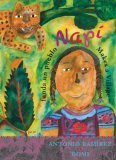 NAPI MAKES A VILLAGE/NAPI FUNDA UN PUEBLO by Antonio Ramirez, illustrated by Domi (Groundwood/Libros Tigrillo) Drawing from the author's own childhood memories, we have the story of a Mazateca girl (from Oaxaca, Mexico) whose family and village is relocated into the jungle so the government can build a dam. There, the community works struggles to tame the wild landscape so they may continue to live and farm there, all under the watchful eye of a stoic jaguar in a tree. When Napi's father is injured in an accident with a workhorse, the jaguar comes to Napi in a dream, soothing her and advising her on what such a little girl might do to help facilitate his healing. Even in the midst of great adversity unique to the geography and circumstance, the universal love of family and the challenges of a big move stays focal in this story. Oversized and especially bright, the simple, folkloric watercolor illustrations have an extreme vibrancy and vim, seeming to bleed into unexpected rainbows and pools in the heat of the jungle's canopy. Children will appreciate the engaging drama of this real
NAPI MAKES A VILLAGE/NAPI FUNDA UN PUEBLO by Antonio Ramirez, illustrated by Domi (Groundwood/Libros Tigrillo) Drawing from the author's own childhood memories, we have the story of a Mazateca girl (from Oaxaca, Mexico) whose family and village is relocated into the jungle so the government can build a dam. There, the community works struggles to tame the wild landscape so they may continue to live and farm there, all under the watchful eye of a stoic jaguar in a tree. When Napi's father is injured in an accident with a workhorse, the jaguar comes to Napi in a dream, soothing her and advising her on what such a little girl might do to help facilitate his healing. Even in the midst of great adversity unique to the geography and circumstance, the universal love of family and the challenges of a big move stays focal in this story. Oversized and especially bright, the simple, folkloric watercolor illustrations have an extreme vibrancy and vim, seeming to bleed into unexpected rainbows and pools in the heat of the jungle's canopy. Children will appreciate the engaging drama of this real conflict combined with the magic of a dream, and the hopeful ending that underscores the resiliency of both the child and the group that works together. Created by two activists for Mexico's native peoples, the story never strays from genuine feeling while never resorting to the didactic; rather, it is an extremely personal story treated with great beauty, sure to build an empathetic bridge across miles of experience for many American children. Alternating Spanish and English text make this an extra marvelous pick for bilingual collections. (7 and up)
conflict combined with the magic of a dream, and the hopeful ending that underscores the resiliency of both the child and the group that works together. Created by two activists for Mexico's native peoples, the story never strays from genuine feeling while never resorting to the didactic; rather, it is an extremely personal story treated with great beauty, sure to build an empathetic bridge across miles of experience for many American children. Alternating Spanish and English text make this an extra marvelous pick for bilingual collections. (7 and up)
Also of interest:
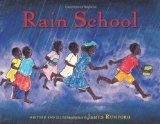
 RAIN SCHOOL by James Rumford (Houghton Mifflin)
RAIN SCHOOL by James Rumford (Houghton Mifflin)
 SILENT MUSIC: A STORY OF BAGHDAD
SILENT MUSIC: A STORY OF BAGHDAD for a few "for instances"), but I think this latest book has a special grace in its unfettered, more minimal telling, and the loose artist's hand lent to lively figures against a clay-colored backdrop. But even though this style seems new, Rumford never loses the thread of the theme that weaves through so many of his books: language and learning is often hard won, a joy worth whatever journey allows us to arrive. And what child wouldn't like to build his or her very own school! (6 and up)
for a few "for instances"), but I think this latest book has a special grace in its unfettered, more minimal telling, and the loose artist's hand lent to lively figures against a clay-colored backdrop. But even though this style seems new, Rumford never loses the thread of the theme that weaves through so many of his books: language and learning is often hard won, a joy worth whatever journey allows us to arrive. And what child wouldn't like to build his or her very own school! (6 and up)
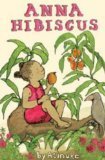
 Speaking of Africa, I also want to give you a heads-up about an especially charming new series: ANNA HIBISCUS
Speaking of Africa, I also want to give you a heads-up about an especially charming new series: ANNA HIBISCUS by Atinuke, illustrated by Lauren Tobia (Kane Miller). Move over, Junie B., Judy Moody and Ramona, make room for your African cousin! Rather than being told in the immediate first person as is the style here in the states, Anna's stories are told more omnisciently, broad enough to bring in the (albeit unspecific) setting of "Africa, beautiful Africa" and with a special read-aloud flair brought to the table by the author's professional storytelling background. Anna lives in a bustling houshold with her African father, Canadian mother and a bevy of cousins, aunts, uncles and elders. In this first volume, Anna goes on vacation, meets with an auntie who has moved to the exotic United States (and hopefully hasn't lost all sense of tradition), creates a problem when she tries to sell oranges like the girls on a neighboring street, and dreams of snow under the African sun...a wish that may surprisingly get granted. This book is straight-up potato chips in that by chapter two it was clear just one wouldn't be nearly enough, and luckily, readers can chomp right into the sequel, HOORAY FOR ANNA HIBISCUS!
by Atinuke, illustrated by Lauren Tobia (Kane Miller). Move over, Junie B., Judy Moody and Ramona, make room for your African cousin! Rather than being told in the immediate first person as is the style here in the states, Anna's stories are told more omnisciently, broad enough to bring in the (albeit unspecific) setting of "Africa, beautiful Africa" and with a special read-aloud flair brought to the table by the author's professional storytelling background. Anna lives in a bustling houshold with her African father, Canadian mother and a bevy of cousins, aunts, uncles and elders. In this first volume, Anna goes on vacation, meets with an auntie who has moved to the exotic United States (and hopefully hasn't lost all sense of tradition), creates a problem when she tries to sell oranges like the girls on a neighboring street, and dreams of snow under the African sun...a wish that may surprisingly get granted. This book is straight-up potato chips in that by chapter two it was clear just one wouldn't be nearly enough, and luckily, readers can chomp right into the sequel, HOORAY FOR ANNA HIBISCUS! which ups the mischief ante. Black and white spot illustrations combine a sensitive line with lots of personality, kind of like an African-influenced Tricia Tusa. These stories are definitely fresh, and full of the vulnerabilities, mischief and unique situations that make a series worthy of a following. Keep 'em coming, Atinuke! (5 and up)
which ups the mischief ante. Black and white spot illustrations combine a sensitive line with lots of personality, kind of like an African-influenced Tricia Tusa. These stories are definitely fresh, and full of the vulnerabilities, mischief and unique situations that make a series worthy of a following. Keep 'em coming, Atinuke! (5 and up)
On a personal note:Thank you for your patience between postings. I am happy to report that as of September I have started a new job at a Chicago Public School (undisclosed) as a school librarian for kindergarten through eighth grade, and I needed time to focus on finding my footing there. It is just about the loveliest and sweetest public school in all of the city, in a fine old building with lots of happy ghosts, and I am so grateful for the opportunity to work with such fine people, both big and little! Now that I am settled in a bit, I look forward to sharing more books both here and there. Happy fall, all!
Links are provided for informational use. Don't forget to support your local bookseller.
More Esmé stuff at www.planetesme.com.

 NAPI MAKES A VILLAGE/NAPI FUNDA UN PUEBLO by Antonio Ramirez, illustrated by Domi (Groundwood/Libros Tigrillo) Drawing from the author's own childhood memories, we have the story of a Mazateca girl (from Oaxaca, Mexico) whose family and village is relocated into the jungle so the government can build a dam. There, the community works struggles to tame the wild landscape so they may continue to live and farm there, all under the watchful eye of a stoic jaguar in a tree. When Napi's father is injured in an accident with a workhorse, the jaguar comes to Napi in a dream, soothing her and advising her on what such a little girl might do to help facilitate his healing. Even in the midst of great adversity unique to the geography and circumstance, the universal love of family and the challenges of a big move stays focal in this story. Oversized and especially bright, the simple, folkloric watercolor illustrations have an extreme vibrancy and vim, seeming to bleed into unexpected rainbows and pools in the heat of the jungle's canopy. Children will appreciate the engaging drama of this real
NAPI MAKES A VILLAGE/NAPI FUNDA UN PUEBLO by Antonio Ramirez, illustrated by Domi (Groundwood/Libros Tigrillo) Drawing from the author's own childhood memories, we have the story of a Mazateca girl (from Oaxaca, Mexico) whose family and village is relocated into the jungle so the government can build a dam. There, the community works struggles to tame the wild landscape so they may continue to live and farm there, all under the watchful eye of a stoic jaguar in a tree. When Napi's father is injured in an accident with a workhorse, the jaguar comes to Napi in a dream, soothing her and advising her on what such a little girl might do to help facilitate his healing. Even in the midst of great adversity unique to the geography and circumstance, the universal love of family and the challenges of a big move stays focal in this story. Oversized and especially bright, the simple, folkloric watercolor illustrations have an extreme vibrancy and vim, seeming to bleed into unexpected rainbows and pools in the heat of the jungle's canopy. Children will appreciate the engaging drama of this real conflict combined with the magic of a dream, and the hopeful ending that underscores the resiliency of both the child and the group that works together. Created by two activists for Mexico's native peoples, the story never strays from genuine feeling while never resorting to the didactic; rather, it is an extremely personal story treated with great beauty, sure to build an empathetic bridge across miles of experience for many American children. Alternating Spanish and English text make this an extra marvelous pick for bilingual collections. (7 and up)
conflict combined with the magic of a dream, and the hopeful ending that underscores the resiliency of both the child and the group that works together. Created by two activists for Mexico's native peoples, the story never strays from genuine feeling while never resorting to the didactic; rather, it is an extremely personal story treated with great beauty, sure to build an empathetic bridge across miles of experience for many American children. Alternating Spanish and English text make this an extra marvelous pick for bilingual collections. (7 and up)Also of interest:

 RAIN SCHOOL by James Rumford (Houghton Mifflin)
RAIN SCHOOL by James Rumford (Houghton Mifflin)Thomas arrives at the schoolyard, but there are no classrooms. There are no desks.And so the children learn to make mud bricks and desks, construct a roof of grass and saplings, and bring in chairs of wood. And inside, amidst the warm smells of fields ready for planting, the children learn and learn and learn. When the big rains come, nine months later, the winds tear at the grass roof, and the walls slump back into sod. "It doesn't matter. The letters have been learned and the knowledge taken away by the children." Come September, the children will be back...and ready to build again. This is a lovely story of renewal and resilience, by an author who has already earned so much admiration for his contribution to readable and fascinating multicultural literature (SEQUOYAH:THE CHEROKKEE MAN WHO GAVE HIS PEOPLE WRITING; TRAVELING MAN: THE JOURNEY OF ABN BATTUTA;
It doesn't matter.
There is a teacher.
"We will build our school," she says. "This is the first lesson."
 SILENT MUSIC: A STORY OF BAGHDAD
SILENT MUSIC: A STORY OF BAGHDAD for a few "for instances"), but I think this latest book has a special grace in its unfettered, more minimal telling, and the loose artist's hand lent to lively figures against a clay-colored backdrop. But even though this style seems new, Rumford never loses the thread of the theme that weaves through so many of his books: language and learning is often hard won, a joy worth whatever journey allows us to arrive. And what child wouldn't like to build his or her very own school! (6 and up)
for a few "for instances"), but I think this latest book has a special grace in its unfettered, more minimal telling, and the loose artist's hand lent to lively figures against a clay-colored backdrop. But even though this style seems new, Rumford never loses the thread of the theme that weaves through so many of his books: language and learning is often hard won, a joy worth whatever journey allows us to arrive. And what child wouldn't like to build his or her very own school! (6 and up)
 Speaking of Africa, I also want to give you a heads-up about an especially charming new series: ANNA HIBISCUS
Speaking of Africa, I also want to give you a heads-up about an especially charming new series: ANNA HIBISCUS by Atinuke, illustrated by Lauren Tobia (Kane Miller). Move over, Junie B., Judy Moody and Ramona, make room for your African cousin! Rather than being told in the immediate first person as is the style here in the states, Anna's stories are told more omnisciently, broad enough to bring in the (albeit unspecific) setting of "Africa, beautiful Africa" and with a special read-aloud flair brought to the table by the author's professional storytelling background. Anna lives in a bustling houshold with her African father, Canadian mother and a bevy of cousins, aunts, uncles and elders. In this first volume, Anna goes on vacation, meets with an auntie who has moved to the exotic United States (and hopefully hasn't lost all sense of tradition), creates a problem when she tries to sell oranges like the girls on a neighboring street, and dreams of snow under the African sun...a wish that may surprisingly get granted. This book is straight-up potato chips in that by chapter two it was clear just one wouldn't be nearly enough, and luckily, readers can chomp right into the sequel, HOORAY FOR ANNA HIBISCUS!
by Atinuke, illustrated by Lauren Tobia (Kane Miller). Move over, Junie B., Judy Moody and Ramona, make room for your African cousin! Rather than being told in the immediate first person as is the style here in the states, Anna's stories are told more omnisciently, broad enough to bring in the (albeit unspecific) setting of "Africa, beautiful Africa" and with a special read-aloud flair brought to the table by the author's professional storytelling background. Anna lives in a bustling houshold with her African father, Canadian mother and a bevy of cousins, aunts, uncles and elders. In this first volume, Anna goes on vacation, meets with an auntie who has moved to the exotic United States (and hopefully hasn't lost all sense of tradition), creates a problem when she tries to sell oranges like the girls on a neighboring street, and dreams of snow under the African sun...a wish that may surprisingly get granted. This book is straight-up potato chips in that by chapter two it was clear just one wouldn't be nearly enough, and luckily, readers can chomp right into the sequel, HOORAY FOR ANNA HIBISCUS! which ups the mischief ante. Black and white spot illustrations combine a sensitive line with lots of personality, kind of like an African-influenced Tricia Tusa. These stories are definitely fresh, and full of the vulnerabilities, mischief and unique situations that make a series worthy of a following. Keep 'em coming, Atinuke! (5 and up)
which ups the mischief ante. Black and white spot illustrations combine a sensitive line with lots of personality, kind of like an African-influenced Tricia Tusa. These stories are definitely fresh, and full of the vulnerabilities, mischief and unique situations that make a series worthy of a following. Keep 'em coming, Atinuke! (5 and up)On a personal note:Thank you for your patience between postings. I am happy to report that as of September I have started a new job at a Chicago Public School (undisclosed) as a school librarian for kindergarten through eighth grade, and I needed time to focus on finding my footing there. It is just about the loveliest and sweetest public school in all of the city, in a fine old building with lots of happy ghosts, and I am so grateful for the opportunity to work with such fine people, both big and little! Now that I am settled in a bit, I look forward to sharing more books both here and there. Happy fall, all!
Links are provided for informational use. Don't forget to support your local bookseller.
More Esmé stuff at www.planetesme.com.
Published on October 24, 2010 16:30
August 17, 2010
1 + 1 = 5 (PICTURE BOOK)
PICTURE BOOK
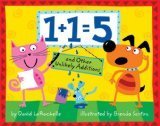 1+1=5 AND OTHER UNLIKELY ADDITIONS
1+1=5 AND OTHER UNLIKELY ADDITIONS by David LaRochelle, illustrated by Brenda Sexton (Sterling, 2010) When does 1+1=5? How about 1 set of triplets + 1 set of twins = 5 babies! Does 1+1=14? Yes, when 1 ant + 1 spider = 14 legs! Sometimes 1+1= hundreds and hundreds, if you are counting the seeds in 1 pumpkin + 1 watermelon! And more traditional number-crunchers needn't worry, 1+1 does ultimately equal 2, if you count two friends. This ingenious book makes the impossible very...
by David LaRochelle, illustrated by Brenda Sexton (Sterling, 2010) When does 1+1=5? How about 1 set of triplets + 1 set of twins = 5 babies! Does 1+1=14? Yes, when 1 ant + 1 spider = 14 legs! Sometimes 1+1= hundreds and hundreds, if you are counting the seeds in 1 pumpkin + 1 watermelon! And more traditional number-crunchers needn't worry, 1+1 does ultimately equal 2, if you count two friends. This ingenious book makes the impossible very...
 1+1=5 AND OTHER UNLIKELY ADDITIONS
1+1=5 AND OTHER UNLIKELY ADDITIONS by David LaRochelle, illustrated by Brenda Sexton (Sterling, 2010) When does 1+1=5? How about 1 set of triplets + 1 set of twins = 5 babies! Does 1+1=14? Yes, when 1 ant + 1 spider = 14 legs! Sometimes 1+1= hundreds and hundreds, if you are counting the seeds in 1 pumpkin + 1 watermelon! And more traditional number-crunchers needn't worry, 1+1 does ultimately equal 2, if you count two friends. This ingenious book makes the impossible very...
by David LaRochelle, illustrated by Brenda Sexton (Sterling, 2010) When does 1+1=5? How about 1 set of triplets + 1 set of twins = 5 babies! Does 1+1=14? Yes, when 1 ant + 1 spider = 14 legs! Sometimes 1+1= hundreds and hundreds, if you are counting the seeds in 1 pumpkin + 1 watermelon! And more traditional number-crunchers needn't worry, 1+1 does ultimately equal 2, if you count two friends. This ingenious book makes the impossible very...
Published on August 17, 2010 23:30
Esmé Raji Codell's Blog
- Esmé Raji Codell's profile
- 148 followers
Esmé Raji Codell isn't a Goodreads Author
(yet),
but they
do have a blog,
so here are some recent posts imported from
their feed.



